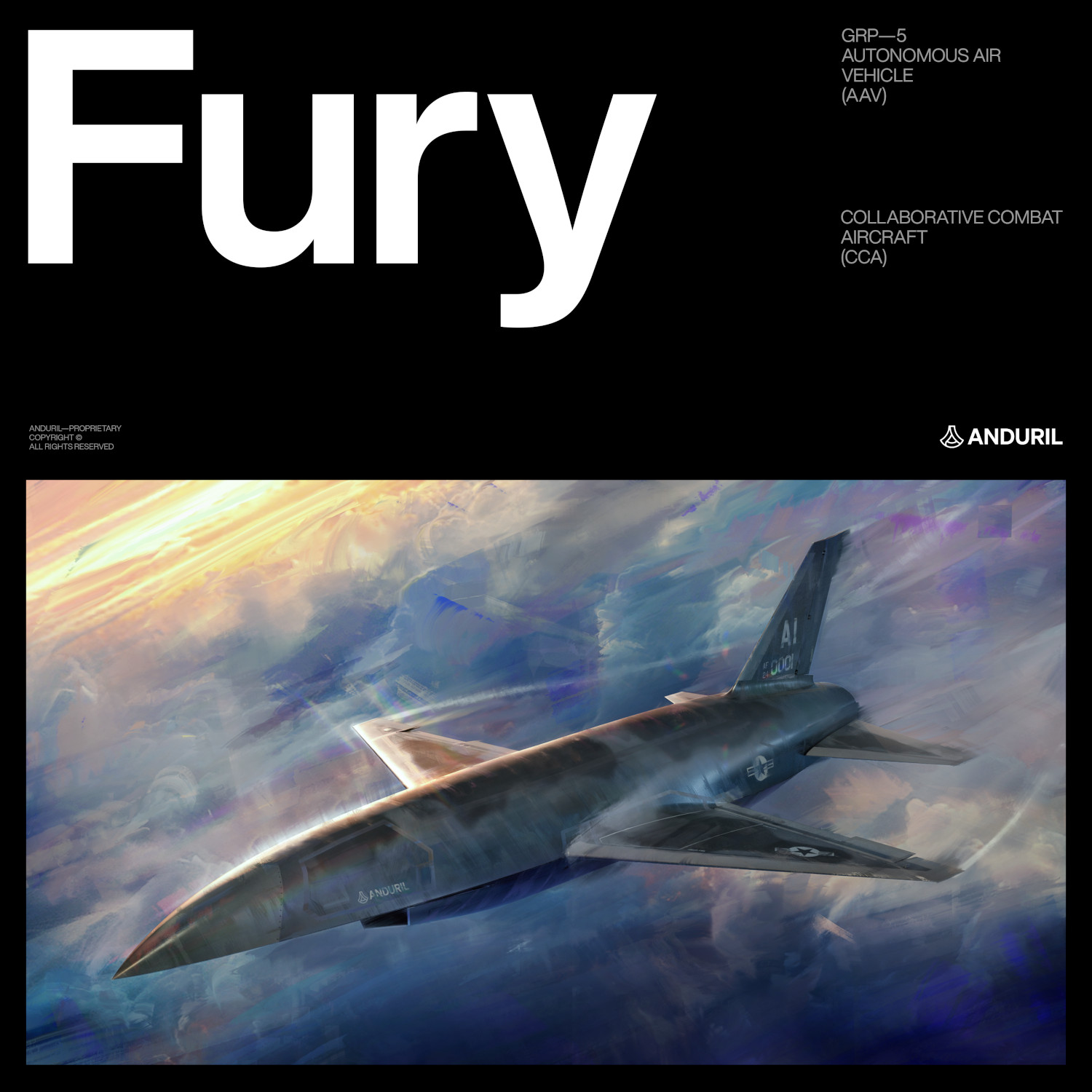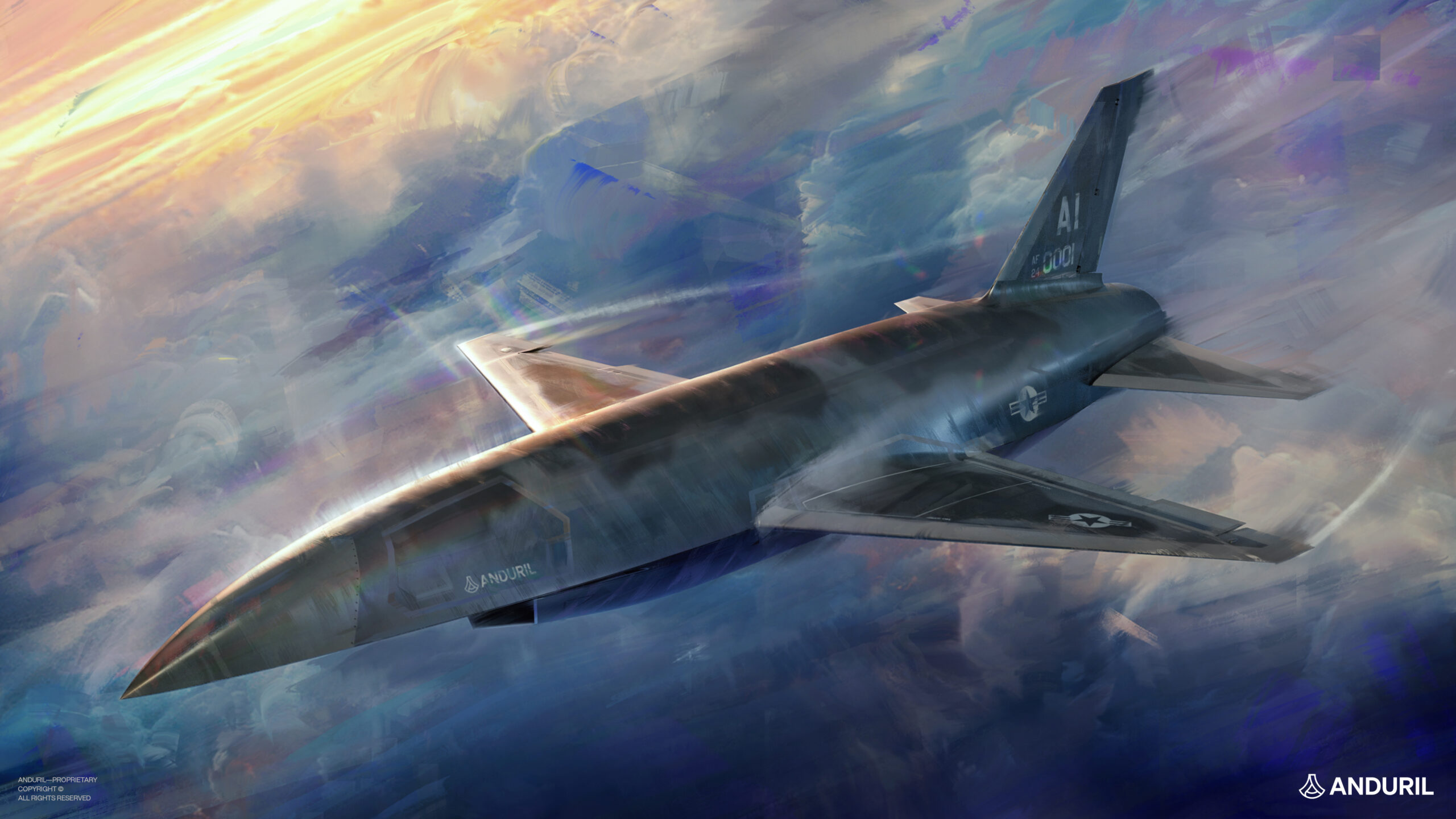Anduril and General Atomics are one step closer to being chosen to build the first drones under the U.S. Air Force’s Collaborative Combat Aircraft (CCA) program. The service is looking to buy at least 1,000 CCAs, and likely many more, as part of the first “increment” of the program. The CCA drones, which will fight alongside crewed types and potentially independently as well, look increasingly set to have a broadly disruptive impact on the Air Force and transform how it fights in the future.
Anduril and General Atomics will now move on to work on “detailed designs, manufacture, and testing of production representative test articles,” according to an Air Force press release. Information about drone designs the two companies are pitching remains limited. Anduril has declined to say in the past whether its offering is related to its stealthy Fury drone, which you can read more about in great detail in this past War Zone feature. A General Atomics’ Gambit family has been seen as one potential source for that company’s CCA design.

Back in February, Secretary of the Air Force Frank Kendall had said this down-select would be coming “within just the next few months.” The Air Force had only formally announced the month before that Boeing, General Atomics, Lockheed Martin, Northrop Grumman, and Anduril had received Increment 1 CCA contracts. The expectation is that the service will ultimately select a single design to produce in large numbers as part of this initial phase of the program. However, there remains a possibility multiple offerings could be chosen in the end. The goal is for at least one initial CCA design to be in production no later than 2028.
Though not expressly addressed in today’s announcement, the Air Force awarding only two new Increment 1 CCA contracts may reflect budgetary limitations, as well as other factors.
Picking “three is going to be difficult,” Secterary Kendall had said in February, specifically citing limited existing funding and uncertainty about future budgets. “With some cost sharing from industry, I think we do three, and that would be our preference.”
As already noted, the Air Force has previously said that it plans to buy at least 1,000 CCA drones. The service has also said that the final size of its CCA fleets could be substantially larger, but this could reflect purchases of drones through future increments of the program. The current hope is that CCA’s Increment 2, which could be the first to incorporate foreign participation, will kick off sometime in Fiscal Year 2025.
The 1,000 CCA figure is based around a notional concept of operations involving the pairing of two of these drones with each of the 200 new sixth-generation stealth combat jets the Air Force is looking to acquire, as well as 300 F-35A Joint Strike Fighters. CCA and the sixth-generation combat jet program are both part of the Air Force’s larger Next Generation Air Dominance (NGAD) initiative.

“The CCA program relies upon incremental development, continuous competition with multiple vendors, full-scale prototypes, and speed-to-ramp with available technologies,” an Air Force spokesperson told The War Zone in January. “The DAF [Department of the Air Force] will select the highest performing CCA vendors to produce and field an initial operational capability.”
In addition, the Air Force is already very actively collaborating with other branches of the U.S. military on CCA-related developments, including advanced autonomous capabilities and control architectures. The service is working particularly closely with the U.S. Navy and the two services expect to be able to seamlessly exchange control of future CCA-type drones during future operations.
A host of separate advanced drone and autonomy programs are feeding directly into CCA, as well. This includes the Defense Advanced Research Projects Agency’s (DARPA) Air Combat Evolution (ACE) effort. A major announcement about ACE came just last week when DARPA and the Air Force disclosed that the unique X-62A test jet had flown in a fully autonomous mode in a mock dogfight against a crewed F-16 fighter last year. You more about this milestone flight test and and the challenges ACE is still working to overcome here.

Whether or not the Air Force will be able to realize its CCA ambitions in the first increment of the program very much remains to be seen. Cost and capability questions and concerns have already emerged as signs point to the requirements for the initial batch of these drones involving higher-than-expected performance that would come at a significant price. Secretary Kendall has said the estimated unit cost of an Increment 1 CCA will be between one-third and one-quarter of the unit price of an F-35, which would be around $20.5 and $27.5 million based on publicly available information. This is at the very high end of prior cost projections for those drones, which have long been billed as being expected to be relatively cheap.
Significant advancements, if not an outright revolution in development and manufacturing practices are also being seen as increasingly critical to the success of the CCA endeavor.
Overall, concepts currently called “affordable mass” and “speed-to-ramp” are the main underlying drivers behind the CCA program. Affordable mass is all about pursuing lower-cost capabilities to meet growing combat capacity demands, especially in a potential future high-end conflict in the Pacific against China. Speed-to-ramp then is about finding ways to accelerate both development and production of those capabilities. You can read more about all of this in detail here.
The Air Force has now taken an important step forward in the CCA program in choosing Anduril and General Atomics to continue maturing their respective designs.
UPDATE: 7:30 PM EST—
With Anduril and General Atomics now selected to proceed in the CCA program’s Increment 1, the goal is to “make a competitive production decision ” sometime in Fiscal Year 2026, according to the Air Force’s press release.
“The DAF’s [Department of the Air Force] option exercise decision does not exclude any of the vendors from competing for the future Increment 1 production contract,” the release adds. “The companies not selected to build these production representative CCA vehicles, and execute the flight test program, will continue to be part of the broader industry partner vendor pool consisting of more than 20 companies to compete for future efforts, including future production contracts.”
The Air Force is still eying foreign partnerships as part of the CCA program and now says that these could come in part through the Foreign Military Sales (FMS) program. This “will help provide further affordable mass at scale while driving horizontal integration and interoperability across our international partnerships,” according to the Air Force.
“Initial activities” related to Increment 2 are also expected to begin by the end of this year. The 2025 Fiscal Year starts on October 1.
“Just over 2 years ago, we announced our intent, as part of our Operational Imperatives, to pursue collaborative combat aircraft. Now, following the enactment of the fiscal year 2024 budget, we’re exercising option awards to two companies to construct production representative test articles,” Air Force Secretary Frank Kendall said in a statement. “The progress we’ve made is a testament to the invaluable collaboration with industry, whose investment alongside the Air Force has propelled this initiative forward. It’s truly encouraging to witness the rapid execution of this program.”
“We executed an acquisition and funding strategy for CCA with early operator, technologist, acquirer, and industry teaming to quickly iterate requirements given our fielding timelines. Continuous competition is a cornerstone at every stage of this program,” he added. “The transparency and teamwork between industry and government really accelerated how quickly we could mature the CCA program.”
Anduril has now confirmed to The War Zone that a version of the Fury design is its CCA offering. The CCA configuration, seen in the rendering at the top of this story and below, looks very close to the baseline Fury design that has been shown before.

For Anduril, a relative newcomer in the U.S. defense industrial space, but a steadily up-and-coming one, this is a particularly significant contract.
“There is no time to waste on business as usual. With the CCA program, Secretary Kendall and the Air Force have embraced a fast-moving, forward-looking approach to field autonomous systems at speed and scale,” Brian Schimpf, Anduril’s CEO and Co-Founder, said in a statement. “We are honored to be selected for this unprecedented opportunity, which signals a demand for continued expansion of the defense industrial base. Anduril is proud to pave the way for other non-traditional defense companies to compete and deliver on large scale programs.”
“Anduril’s work on this program is just beginning,” Jason Levin, Senior Vice President of Anduril’s Air Dominance & Strike Division, also said. “U.S. and allied success in the future requires CCAs to be delivered at a speed, cost, and scale to beat the pacing threat. We look forward to continuing our partnership with the U.S. Air Force to deliver this critical capability to our Airmen as quickly as possible.”
Anduril is not currently a major airframer and does not have large established production facilities to support such work. This is interesting to note given the Air Force’s explicit statement about the potential for other companies to be involved in the production of whatever design or designs it ultimately chooses to produce under Increment 1. No matter who is selected in the end as the prime contractor, a large pool of manufacturer partners will likely be key to meeting the Air Force’s production volume and schedule goals.
General Atomics is a much more established drone maker with serial airframe production experience. A company press release does not expressly say its CCA design is based on any of its known drones.
However, a rendering the company has now released seen below, shows similarities to a member of the Gambit family. It may also leverage experience with the XQ-67A design. The XQ-67A, which The War Zone was first to report on and that first flew in February, was developed for the Air Force’s separate Off-Board Sensing Station (OBSS) program. You can learn more about OBSS here.

“To complement the CCA contract, GA-ASI will continue to conduct a series of autonomy and mission system tests on the MQ-20 Avenger UAS and XQ-67A to accelerate the readiness of operational autonomy,” the company’s press release adds. “These live flight tests will continue to demonstrate the readiness of the full mission capability to support the emerging U.S. Air Force Autonomous Collaborative Platforms (ACP).”

The Gambit and XQ-67A designs are markedly different from Anduril’s Fury. The Gambit family, in particular, is based on a novel concept involving a common core ‘chassis’ onto which different airframe designs can be readily mated.

“The CCA program redefines the future of aviation and will shape the USAF acquisition model to deliver affordable combat mass to the warfighter at the speed of relevancy,” Mike Atwood, Vice President of Advanced Programs for General Atomics Aeronautical Systems, Inc. (GA-ASI), said in a statement.
“Throughout our 30-year history, GA-ASI has been at the forefront of rapidly advancing unmanned aircraft systems that support our warfighters,” GA-ASI’s President David R. Alexander, also said. “The USAF is moving forward with GA-ASI due to our focused commitment to unmanned air-to-air combat operations and unmatched UAS experience, ensuring the production of the CCA aircraft at scale to deliver affordable combat mass for the warfighter.”
Contact the author: joe@twz.com
